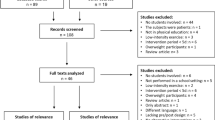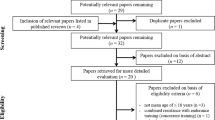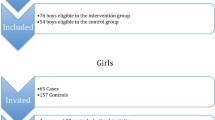Abstract
Background
Strength training (ST) uses different training methods, such as free weights, body weight, elastic bands or machines to generate resistance force. There is evidence of the ST benefits, however, many professionals have resistance about the applicability of this type of training for children and adolescents, especially at schools.
Purpose
To describe the possible risks, benefits and pedagogical possibilities of ST in school Physical Education.
Methods
The search was carried out in the databases PubMed, SciELO, Web of Science and Scholar Google, using followed terms: (i) strength/endurance training, (ii) risks, benefits, (iii) children/adolescents and (iv) physical education. Studies published in the last twenty years in English, Spanish and Portuguese were included.
Results
There is no evidence to support the hypothesis that ST promotes a growth deficit or a higher injure risk. The ST benefits for this population are extensive, such as an increase in muscular fitness and bone mass, production of IGF-1 growth factor, regulation of body fat, cardiovascular and lipid profile, increase in motor development or sports performance. Physical Education teachers can include ST for students from the age of 6 years and older, through training strategies with their own body weight and simple equipment (e.g., balls and ropes). The focus of ST for prepubertal children should be neuromuscular, that is, in the quality of the movements’ execution.
Conclusion
ST is positive for children and adolescents development and evidence indicates many benefits. It is recommended that it be included in Physical Education classes through pedagogical activities and adapted strategies.


Similar content being viewed by others
References
García-Hermoso A, Ramírez-Campillo R, Izquierdo M (2019) Is muscular fitness associated with future health benefits in children and adolescents? A systematic review and meta-analysis of longitudinal studies. Sport Med 49:1079–1094. https://doi.org/10.1007/s40279-019-01098-6
Solis-Urra P, Sanchez-Martinez J, Olivares-Arancibia J et al (2021) Physical fitness and its association with cognitive performance in Chilean schoolchildren: The Cogni-Action Project. Scand J Med Sci Sports. https://doi.org/10.1111/sms.13945
Torres-Costoso A, López-Muñoz P, Martínez-Vizcaíno V et al (2020) Association between muscular strength and bone health from children to young adults: a systematic review and meta-analysis. Sport Med 50:1163–1190. https://doi.org/10.1007/s40279-020-01267-y
Bull FC, Al-Ansari SS, Biddle S et al (2020) World Health Organization 2020 guidelines on physical activity and sedentary behaviour. Br J Sports Med 54:1451–1462. https://doi.org/10.1136/bjsports-2020-102955
Faigenbaum AD, MacDonald JP, Stracciolini A, Rebullido TR (2020) Making a strong case for prioritizing muscular fitness in youth physical activity guidelines. Curr Sports Med Rep 19:530–536. https://doi.org/10.1249/JSR.0000000000000784
Faigenbaum AD (2000) Strength training for children and adolescents. Clin Sports Med 19:593–619. https://doi.org/10.1016/S0278-5919(05)70228-3
Stricker PR, Faigenbaum AD, McCambridge TM (2020) Resistance training for children and adolescents. Pediatrics. https://doi.org/10.1542/peds.2020-1011
Faigenbaum AD, Myer GD (2010) Pediatric resistance training: Benefits, concerns, and program design considerations. Curr Sports Med Rep 9:161–168. https://doi.org/10.1249/JSR.0b013e3181de1214
Sociedad Argentina de Pediatría (2018) Entrenamiento de la fuerza en niños y adolescentes: beneficios, riesgos y recomendaciones. Arch Argent Pediatr 116:S82–S91. https://doi.org/10.5546/aap.2018.s82
Ughini CC, Becker C, Pinto RS (2011) Treinamento de força em crianças: segurança, benefícios e recomendações. Conexões 9:177–197
Abarca-Gómez L, Abdeen ZA, Hamid ZA et al (2017) Worldwide trends in body-mass index, underweight, overweight, and obesity from 1975 to 2016: a pooled analysis of 2416 population-based measurement studies in 128·9 million children, adolescents, and adults. Lancet 390:2627–2642. https://doi.org/10.1016/S0140-6736(17)32129-3
Thompson WR (2021) Worldwide survey of fitness trends for 2021. ACSMs Health Fit J 25:10–19. https://doi.org/10.1249/FIT.0000000000000631
Benedet J, Freddi JC, Luciano AP et al (2013) Treinamento resistido para crianças e adolescentes. ABCS Heal Sci 38:47–51. https://doi.org/10.7322/abcshs.v38i1.7
Masanovic B, Gardasevic J, Marques A et al (2020) Trends in physical fitness among school-aged children and adolescents: a systematic review. Front Pediatr. https://doi.org/10.3389/fped.2020.627529
Dooley FL, Kaster T, Fitzgerald JS et al (2020) A systematic analysis of temporal trends in the handgrip strength of 2,216,320 children and adolescents between 1967 and 2017. Sport Med 50:1129–1144. https://doi.org/10.1007/s40279-020-01265-0
Faigenbaum AD, Kraemer WJ, Blimkie CJR et al (2009) Youth resistance training: updated position statement paper from the national strength and conditioning association. J Strength Cond Res 23:S60–S79. https://doi.org/10.1519/JSC.0b013e31819df407
Beneli L de MF de AA, Piagentini (2012) Ensaios e Ciência. Ensaios e Ciência Ciências Biológicas, Agrárias e da Saúde 16:117–131
Gagliardi EDMM, Silva AO (2011) Benefícios do treinamento de força para escolares.https://doi.org/10.5102/ucs.v9i2.1372. Univ Ciências da Saúde 9:. https://doi.org/10.5102/ucs.v9i2.1372
Bukowsky M, Faigenbaum AD, Myer GD (2014) FUNdamental Integrative Training (FIT) for Physical Education. J Phys Educ Recreat Danc 85:23–30. https://doi.org/10.1080/07303084.2014.926842
Myers AM, Beam NW, Fakhoury JD (2017) Resistance training for children and adolescents. Transl Pediatr 6:137–143
Wilmore JH, Costill DL, Kenny WL (2010) Fisiologia do esporte e do exercício., 2nd ed. Manole, Barueri
Knuttgen HG, Kraemer WJ (1987) Terminology and measurement in exercise performance. J Strength Cond Res 1:1–10. https://doi.org/10.1519/00124278-198702000-00001
Gallahue DL, Ozmun JC, Goodway JD (2013) compreendendo o desenvolvimento motor. 7th ed. AMGH, Porto Alegre
Ré AHN (2011) Crescimento, maturação e desenvolvimento na infância e adolescência: Implicações para o esporte. Motricidade 7:55–67. https://doi.org/10.6063/motricidade.7(3).103
Alves C, Lima RVB (2008) Impacto da atividade física e esportes sobre o crescimento e puberdade de crianças e adolescentes. Rev Paul Pediatr 26:383–391. https://doi.org/10.1590/s0103-05822008000400013
Fort-Vanmeerhaeghe A, Romero-Rodriguez D, Lloyd RS et al (2016) Integrative neuromuscular training in youth athletes. Part II: strategies to prevent injuries and improve performance. Strength Cond J 38:9–27. https://doi.org/10.1519/SSC.0000000000000234
Bernhardt DT, Gomez J, Johnson MD et al (2001) Strength training by children and adolescents. Pediatrics 107:1470–1472. https://doi.org/10.1542/peds.107.6.1470
Falk B, Tenenbaum G (1996) The effectiveness of resistance training in children. A meta-analysis. Sport Med 22:176–186. https://doi.org/10.2165/00007256-199622030-00004
Costa HS, Lisboa MP, Ataides J s M de, et al (2017) Revista Brasileira de Pesquisa em Ciências da Saúde. Positions statements on strength training for children and adolescents: A Revista Brasileira de Pesquisa em Ciências da Saúde. 4:39–49
Barbieri D (2016) Strength training for children and adolescents : benefits and risks strength training for children and adolescents : benefits and risks. 37:219–225
Silva Perfeito R, Magalhães de Souza WM, de Sá Alves DG (2013) Treinamento de força muscular para crianças e adolescentes: Benefícios ou malefícios? Adolesc e Saude 10:54–62
Hamill BP (1994) Relative safety of weightlifting and weight training. J Strength Cond Res 8:53–57
García-Hermoso A, Alonso-Martínez AM, Ramírez-Vélez R et al (2020) Association of physical education with improvement of health-related physical fitness outcomes and fundamental motor skills among youths. JAMA Pediatr. https://doi.org/10.1001/jamapediatrics.2020.0223
Faigenbaum AD (2018) Youth resistance training: the good, the bad, and the ugly-the year that was 2017. Pediatr Exerc Sci 30:19–24. https://doi.org/10.1123/pes.2017-0290
Lima FC, Costa SDP, Rodrigues BM et al (2014) Treinamento resistido na Educação Física Escolar : uma proposta de ensino Endurance training in physical education : a proposal for teaching. Cinergis 15:207–217
Faigenbaum AD, Rebullido TR, Peña J, Chulvi-Medrano I (2019) Resistance exercise for the prevention and treatment of pediatric dynapenia. J Sci Sport Exerc 1:208–216. https://doi.org/10.1007/s42978-019-00038-0
Lauersen JB, Andersen TE, Andersen LB (2018) Strength training as superior, dose-dependent and safe prevention of acute and overuse sports injuries: a systematic review, qualitative analysis and meta-analysis. Br J Sports Med 52:1557–1563. https://doi.org/10.1136/bjsports-2018-099078
Faigenbaum AD, MacDonald JP, Haff GG (2019) Are young athletes strong enough for sport? DREAM On. Curr Sports Med Rep 18:6–8. https://doi.org/10.1249/JSR.0000000000000554
Bailey DA, Mirwald RL, Faulkner RA (2004) Bone growth and exercise studies: the complications of maturation. J Musculoskelet Neuronal Interact 3:335–337
Gunter KB, Almstedt HC, Janz KF (2012) Physical activity in childhood may be the key to optimizing lifespan skeletal health. Exerc Sport Sci Rev 40:13–21. https://doi.org/10.1097/JES.0b013e318236e5ee
Gómez-Bruton A, Marín-Puyalto J, Muñiz-Pardos B et al (2020) Association between physical fitness and bone strength and structure in 3- to 5-year-old children. Sport Heal A Multidiscip Approach. https://doi.org/10.1177/1941738120913645
Smith JJ, Eather N, Morgan PJ et al (2014) The health benefits of muscular fitness for children and adolescents: a systematic review and meta-analysis. Sport Med 44:1209–1223. https://doi.org/10.1007/s40279-014-0196-4
Fritz J, Rosengren BE, Dencker M et al (2016) A seven-year physical activity intervention for children increased gains in bone mass and muscle strength. Acta Paediatr 105:1216–1224. https://doi.org/10.1111/apa.13440
Mello JB, Pedretti A, García-Hermoso A et al (2021) Exercise in school Physical Education increase bone mineral content and density: systematic review and meta-analysis. Eur J Sport Sci 21:9. https://doi.org/10.1080/17461391.2021.1960426
Giannaki CD, Aphamis G, Tsouloupas CN et al (2016) An eight week school-based intervention with circuit training improves physical fitness and reduces body fat in male adolescents. J Sports Med Phys Fitness 56:894–900
Bea JW, Blew RM, Howe C et al (2017) Resistance training effects on metabolic function among youth: a systematic review. Pediatr Exerc Sci 29:297–315. https://doi.org/10.1123/pes.2016-0143
Yu CCW, Sung RYT, So RCH et al (2005) Effects of strength training on body composition and bone mineral content in children who are obese. J Strength Cond Res 19:667–672. https://doi.org/10.1519/14994.1
Yu CCW, Sung RYT, Hau KT et al (2008) The effect of diet and strength training on obese children’s physical self-concept. J Sports Med Phys Fitness 48:76–82
Mcguigan MR, Tatasciore M, Newton RU, Pettigrew S (2009) Eight weeks of resistance training can significantly alter body composition in children who are overweight or obese. J Strength Cond Res 23:80–85. https://doi.org/10.1519/JSC.0b013e3181876a56
Ruiz JR, Castro-Pinero J, Artero EG et al (2009) Predictive validity of health-related fitness in youth: a systematic review. Br J Sports Med 43:909–923. https://doi.org/10.1136/bjsm.2008.056499
Contreras-Osorio F, Campos-Jara C, Martínez-Salazar C et al (2021) Effects of sport-based interventions on children’s executive function: a systematic review and meta-analysis. Brain Sci 11:755. https://doi.org/10.3390/brainsci11060755
Lubans DR, Cliff DP (2011) Muscular fitness, body composition and physical self-perception in adolescents. J Sci Med Sport 14:216–221. https://doi.org/10.1016/j.jsams.2010.10.003
Padilla-Moledo C, Ruiz JR, Ortega FB et al (2012) Associations of muscular fitness with psychological positive health, health complaints, and health risk behaviors in spanish children and adolescents. J Strength Cond Res 26:167–173. https://doi.org/10.1519/JSC.0b013e31821c2433
Donnelly JE, Hillman CH, Castelli D et al (2016) Physical activity, fitness, cognitive function, and academic achievement in children. Med Sci Sport Exerc 48:1197–1222. https://doi.org/10.1249/MSS.0000000000000901
Álvarez-Bueno C, Pesce C, Cavero-Redondo I et al (2017) The effect of physical activity interventions on children’s cognition and metacognition: a systematic review and meta-analysis. J Am Acad Child Adolesc Psychiatry 56:729–738. https://doi.org/10.1016/j.jaac.2017.06.012
García-Hermoso A, Ramírez-Vélez R, Lubans DR, Izquierdo M (2021) Effects of physical education interventions on cognition and academic performance outcomes in children and adolescents: a systematic review and meta-analysis. Br J Sports Med. https://doi.org/10.1136/bjsports-2021-104112
Biddle SJH, Ciaccioni S, Thomas G, Vergeer I (2019) Physical activity and mental health in children and adolescents: an updated review of reviews and an analysis of causality. Psychol Sport Exerc 42:146–155. https://doi.org/10.1016/j.psychsport.2018.08.011
Rodriguez-Ayllon M, Cadenas-Sánchez C, Estévez-López F et al (2019) Role of physical activity and sedentary behavior in the mental health of preschoolers, children and adolescents: a systematic review and meta-analysis. Sport Med 49:1383–1410. https://doi.org/10.1007/s40279-019-01099-5
Ruiz JR, Ortega FB, Wärnberg J et al (2008) Inflammatory proteins and muscle strength in adolescents. Arch Pediatr Adolesc Med 162:462. https://doi.org/10.1001/archpedi.162.5.462
Ruivo RM, Pezarat-Correia P, Carita AI (2017) Effects of a resistance and stretching training program on forward head and protracted shoulder posture in adolescents. J Manipulative Physiol Ther 40:1–10. https://doi.org/10.1016/j.jmpt.2016.10.005
Lima, Cláudia Silveira; Pinto RS (2009) Cinesiologia e Musculação. Artmed, Porto Alegre
Young WK, Metzl JD (2010) Strength training for the young athlete. Pediatr Ann 39:293–299. https://doi.org/10.3928/00904481-20100422-10
Tsigilis N, Douda H, Tokmakidis SP (2002) Test-retest reliability of the Eurofit test battery administered to university students. Percept Mot Skills 95:1295–1300. https://doi.org/10.2466/pms.2002.95.3f.1295
Ruiz JR, España Romero V, Castro Piñero J et al (2011) ALPHA-fitness test battery: health-related field-based fitness tests assessment in children and adolescents. Nutr Hosp 26:1210–1214. https://doi.org/10.3305/nh.2011.26.6.5270
Ortega FB, Cadenas-Sánchez C, Sánchez-Delgado G et al (2015) Systematic review and proposal of a field-based physical fitness-test battery in preschool children: the PREFIT battery. Sports Med 45:533–555. https://doi.org/10.1007/s40279-014-0281-8
Welk GJ, De Saint-Maurice Maduro PF, Laurson KR, Brown DD (2011) Field evaluation of the new FITNESSGRAM® criterion-referenced standards. Am J Prev Med 41:S131–S142. https://doi.org/10.1016/j.amepre.2011.07.011
American Alliance for Health, Physical Education, Recreation and D (1980) AAHPERD Lifetime Health Related Physical Fitness: Test Manual. Reston
Gaya AR, Gaya ACA, Pedretti A, Mello JB (2021) Projeto Esporte Brasil: Manual de medidas, testes e avaliações, 5th ed. Porto Alegre
Faigenbaum AD, Milliken LA, Westcott WL (2003) Maximal strength testing in healthy children. J strength Cond Res 17:162–166. https://doi.org/10.1519/1533-4287(2003)017%3c0162:mstihc%3e2.0.co;2
Faigenbaum AD, Milliken L, Moulton L, Westcott WL (2005) Early muscular fitness adaptations in children in response to two different resistance training regimens. Pediatr Exerc Sci 17:237–248. https://doi.org/10.1123/pes.17.3.237
Carnevale Pellino V, Giuriato M, Ceccarelli G et al (2020) Explosive strength modeling in children: trends according to growth and prediction equation. Appl Sci 10:6430. https://doi.org/10.3390/app10186430
Oliveira L, Braga F, Lemes V et al (2017) Effect of an intervention in Physical Education classes on health related levels of physical fitness in youth. Rev Bras Atividade Física Saúde 22:46–53
Funding
No sources of funding were used to assist in the preparation of this review.
Author information
Authors and Affiliations
Corresponding author
Ethics declarations
Conflict of interest
The authors declare that they have no competing interests.
Ethical approval
This article does not contain any studies with human or animal participants.
Informed consent
For this type of study, formal consent is not required.
Additional information
Publisher's Note
Springer Nature remains neutral with regard to jurisdictional claims in published maps and institutional affiliations.
Rights and permissions
About this article
Cite this article
dos Santos Duarte Junior, M.A., López-Gil, J.F., Caporal, G.C. et al. Benefits, risks and possibilities of strength training in school Physical Education: a brief review. Sport Sci Health 18, 11–20 (2022). https://doi.org/10.1007/s11332-021-00847-3
Received:
Accepted:
Published:
Issue Date:
DOI: https://doi.org/10.1007/s11332-021-00847-3




